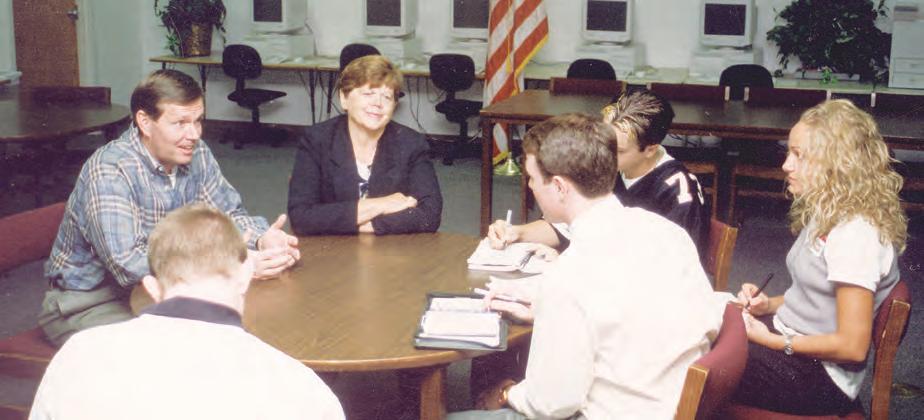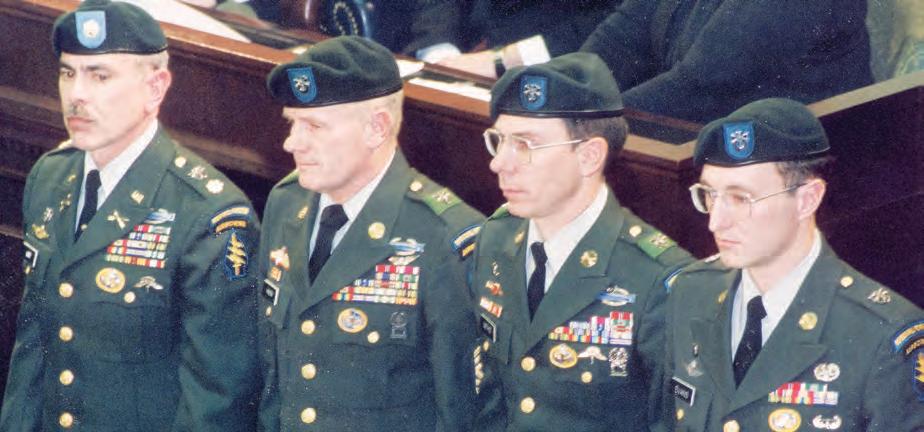
17 minute read
Other Constitutional Relationships
from Real and Right
The Utah Constitution, like the U.S. Constitution, provides for three branches of government: executive, legislative, and judicial, with checks and balances working the same way as in the U.S. Constitution. That’s the written framework, but reality and execution tend to be a bit more complicated. As one example of this, the state’s other constitutional officers who would traditionally be thought of as part of the executive branch are elected independently.
Another thing that can cause complications is Utah’s Constitution also establishes a separate system of schools. The Utah State Board of Education is a separate constitutional entity. Were it not for the schools’ dependence on the legislature for money, and certain responsibilities of the governor in the way members of the school board get elected, the school system would operate with complete autonomy. Likewise, the legislature also created an independent system of higher education. Thegovernor has influence through his or her authority to appoint members to their respective governing boards and through the budget-setting process, but beyond that the higher education system operates quite independently.
Likewise, the governor is the commander in chief of the Utah National Guard, but the relationship the National Guard has with the U.S. Army makes it a shared power relationship.
All of these relationships create tension within government, and as governor I had to navigate relationship dynamics among and between various other state entities and individuals.
State Officers
On January 4, 1993, when I took the oath of office for the first time, three other state officials took the same oath. Ed Alter was sworn in as state treasurer for a third four-year term. He would go on to serve four more terms. State auditor Tom Allen had first been elected in the 1984 election, and this was his third term as well. Also sworn in with us that day was Jan Graham, the state’s first female attorney general.
Ed and Tom were Republicans. Jan was a Democrat, elected after defeating Scott Burns in a hotly contested race. Ed Alter continued to serve until 2009, when he retired after twenty-eight years as treasurer. Tom Allen left his position in 1995, when he was made chairman of the Government Accounting Standards Board, a group the Deseret News described as “the Supreme Court of the accounting profession.”1 Consequently, I appointed his deputy, Auston Johnson, to replace him as state auditor. Auston served until 2013.
I felt the roles of the state treasurer and state auditor as separately elected officials worked fine. It certainly created accountability, and all three of the men who served during my time as governor just did their jobs and didn’t get enmeshed in politics or policy. We had a collaborative and professional relationship during my entire tenure.
My relationship with Jan Graham, however, was a bit rockier. Though we both worked at keeping the relationship professional and civil, we had several significant tensions at times. The fact is, all the elements that make relationships difficult existed between us.
First of all, we were in different parties. Jan was the only statewide elected Democrat at the time. She was smart, likeable, and popular—the hope of the Democratic Party in Utah. She was the only Democrat at the time who could have been considered a legitimate political threat to me or Senators Orrin Hatch and Bob Bennett. Jan and I had different philosophies on many issues and vastly different political bases to satisfy.
Perhaps the most difficult challenge was the differences in our views about the role of the attorney general. Jan, for reasons I completely understand, felt that since she too had been elected by the people, she was therefore empowered to make the strategic decisions on litigation the state engaged in.
I viewed the attorney general as the state’s lawyer, and I, as chief executive officer of the executive branch of state government, was the client. Likewise, I viewed every state agency as her client. I believe she had not just a constitutional requirement to fulfill that role due to her position within the executive branch, but also a duty under the ethics of the legal profession to represent the wishes of her client.
This became a significant issue when at one point the state lost a lower court decision on a case related to abortion. The state legislature wanted to push the federal courts to allow a more restrictive law. The way to do that was to appeal the case to the Eighth Circuit Court, and then potentially to the Supreme Court. Jan was pro-choice and made a unilateral decision, without consulting with me (Utah’s chief executive), to not appeal it. I decided to hire an outside attorney, Mary Ann Woods, to file an appeal on my behalf. During that period, I also threatened to pursue a constitutional amendment clarifying who directed legal policy, but ultimately chose not to.
We had other substantial differences of opinion regarding issues or litigation, such as the action brought in 1993 by the National Center for Youth Law over Utah’s child welfare and protection system, and the 1998 settlement of a nationwide case involving nearly all fifty states and the major U.S. tobacco companies. In each of these cases, the attorney general made key decisions that impacted the state’s budget, to the tune of hundreds of millions of dollars, without seeking agreement from the client, the state.
Public Education
Most governors run for office pledging to improve education. I was no exception. The reality is, however, that governors have no direct controls with which they can impact the public schools. The Utah Constitution established the public school system as an independent entity with its own system of governance. State Board of Education members, until 2020, were elected in nonpartisan elections. The State School Board, in turn, appoints and hires the State Superintendent. Utah’s local school boards operate the same way.
However, while the governor and the legislature have no direct powers to affect education, the influences they do have are powerful levers. The most significant is the budget. The Utah Constitution requires that students statewide be provided with free public education. In fact, the Constitution originally committed state income taxes exclusively to the funding of public K-12 education. During my service, the Constitution was amended to allow income tax to be used additionally for certain aspects of higher education. Schools get some property tax as well, but it is limited. The state uses income tax as a means of equalizing the amount spent in different parts of the state.

Consequently, whenever state government— through the governor and legislature—wants to alter the direction of the public schools, it is done by requiring the State Board of Education to accept the changes as a condition of receiving the state’s tax money.
The introduction of charter schools in Utah is a prime example of budgetary and lawmaking leverage. Charter schools were launched under my administration and with my backing. Subsequently, the number of charter schools have grown rapidly throughout the state and have been an integral component of the public education system ever since.
School vouchers and tuition tax credits, on the other hand, have had little success. During my tenure, many members of the legislature and various conservative organizations in the state pushed for the introduction of a voucher system. Public schools, they argued, were unresponsive, bureaucratic, and ineffective. If the state gave each student a voucher and the choice for parents to spend it on whatever school they determined was best—private schools namely—it would foster competition. The marketplace would reward the good schools and force the less effective ones to improve or close.
All of these relationships create tension within government, and as governor I had to navigate relationship dynamics among and between various other state entities and individuals.
While I agreed with many of their arguments, I saw problems with vouchers. One significant downside was the fact that vouchers would create inequality, because most private schools require substantial tuition in addition to the voucher.
In the final analysis, I took the charter school route, in which private individuals or entities, rather than government, created schools, and state money followed the student—providing the same benefits as vouchers but avoiding many of the pitfalls. The State School Board and local school districts were strongly against charter schools. So, to effect change in a system where the governor and legislature have no direct control of the school system, state education appropriation bills had to be written in a way that compelled the School Board to follow the law or operate without funding.
A second power the governor possesses is involvement in the way the State School Board gets elected. It’s a two-part selection and election process. The governor appoints selection committees, who narrow all formally declared candidates down to three. The committees send those names back to the governor, who then chooses two to be on the election ballot. A year before I became governor, the legislature had changed the system, switching it from direct primary and general elections of state board members to the selection-committee process involving the governor. In very recent years, the system has been tweaked a few more times, including a change that now allows State School Board candidates to file and run for office with political party affiliations.
The third tool the governor uniquely has is the bully pulpit. This is one of the reasons I visited schools so often (I visited a school every week on average during my first term as part of a campaign promise) because I was able to generate substantial momentum for various initiatives.
Over the years I was governor, I enjoyed positive relationships with the school community; they knew I was an advocate. The most tension we had was over the charter school initiative, though I believe time has vindicated my position.
Higher Education
Some years before I became governor, I was appointed to the Board of Trustees of Southern Utah State College and soon after was elected chairman of the Board. Four years later, I was appointed as a member of the State Board of Regents, the governing board of the Utah System of Higher Education.
The fact that there is a Utah System of Higher Education is in large measure because of my dad, Dixie Leavitt. While he was majority leader of the Utah Senate, he came to see the serious problems created when every university and college approached the legislature independently and operated without central leadership.
He took on a remarkably complex and difficult political problem of designing a system of higher education, drafting the legislation to implement it, and building the political support to enact it. As I look back over the last fifty years of Utah history, there is no greater legislative achievement than the creation of the Board of Regents system. It was a brilliant piece of work, and my father rarely gets the credit he deserves. It has been long enough that the original people involved have retired or passed away, but it is an achievement that cannot go unacknowledged.
In subsequent years, a separate framework—the Utah System of Technical Colleges—was created to oversee applied technology colleges and programs, and it was governed by its own Board of Trustees. In 2020, those two independent systems were merged into a single Utah System of Higher Education, and the two boards were consolidated into one—a new, eighteen-member Utah Board of Higher Education.
Under the previous system, the legislature passed a higher education budget and the Board of Regents adjudicated it. The governor nominated the Board of Regents and the State Senate confirmed them. Regents hired the commissioner of higher education and the university and college presidents.
The Board of Regents had to be bipartisan. When I appointed Regents, I made very clear to them they were not being appointed to represent an institution or geographic region of the state. Still, the Regent appointments were politically sensitive.
In reality, the governor has limited direct authority over higher education, but there were more levers to pull with higher education than public education. In addition to the budget and the appointment power of Trustees and Regents, the governor had a big public megaphone. Universities need the governor’s support, and it provides great leverage.

I admire those who devote themselves to academia. They contribute mightily. However, during my years as governor I made no secret that I believe the model of higher education in the United States is wasteful and inefficient. Campuses are underutilized. Higher education measures time in a seat, not learning. It is too expensive, takes too long, and too often colleges and universities encourage students to prepare for jobs that don’t exist. The system is insufficiently accountable for results. It is a world replete with elitist notions, where high tuition, exclusive admission standards, and a big brand are mistaken as quality.
These views ultimately resulted in my introduction of three higher education initiatives: Western Governors University (WGU), the Utah College of Applied Technology, and an engineering initiative. All three have achieved their intended result, which I write about in more detail in part two of this volume.
The universities and colleges knew of my skepticism but humored me mostly. They figured my ideas would go away. Some were more direct than others; Bernie Machen, during his inauguration as president of the University of Utah, took a not-soveiled swipe at the ideas behind WGU with me sitting behind him on the stage. However, nearly two decades later, I encountered Bernie at a fundraising event for Mitt Romney. Bernie Machen was president of the University of Florida and attending with a friend of his. He said, “I have to admit, you were right about WGU.”
This is an environment in which knowing and understanding the governor’s limited capacity to make change on higher education campuses caused me to avoid a collision and to instead focus on developing a winning alternative. I did not try to disrupt their model directly; rather, I believed that the unsustainability of the higher education business model would begin to demonstrate its lack of sustainability soon enough, and that I was better off working to build a disruptive competitor that, in time, would be sought out by colleges and university systems in distress. That strategy has proven successful, as I will show in the later chapter about WGU.

The National Guard
The governors of the fifty states serve as the commanders in chief of the National Guard in their respective states. The first book of my personal history details my service as a soldier and officer in the Utah Army National Guard. It was a positive experience, but one I did not miss after it ended. However, it was gratifying to catapult over the course of my life from second lieutenant to commander in chief. Only two Utah governors have served in the Guard—me and Gary Herbert.
The role of commander in chief was born of the tradition in the United States of civilian control of the military. Accordingly, the president of the United States must nominate general officers, and then the military reports to the president and only the president can deploy them. All of those things are true at the state level for the governor and the National Guard.
The governor nominates the adjutant general of the National Guard. John Matthews was serving when I became governor and I asked him to continue. Technically, the adjutant general serves a sixyear term, but if the governor asked for a resignation, the adjutant general would comply. John was a wonderful man and officer. After retiring, I asked him to serve on my own staff as a military advisor.
Upon John’s retirement, I appointed Jim Miller, who was already a major general. He had, as a National Guard officer, commanded a significant portion of the United States artillery forces. This is an indication about how closely integrated the National Guard and regular army have become. Jim was highly respected.
Appointing Jim Miller was not just logical because of his fine military career. He had been a teacher and mentor to me throughout my youth. He was actually my fifth-grade teacher and taught American history at Cedar High School. Jim was highly influential in my decision to join the National Guard and become an officer. And by the time I became an officer, Jim had advanced to battalion commander. He had influenced my life for good in many ways, and I was delighted that circumstances evolved so I could serve with him again.

When it came time to replace Jim Miller, I concluded to reach a ways down into the ranks of the National Guard for my appointment. I passed over several general officers and appointed Brian Tarbet, who was also a lawyer with the Attorney General’s Office. I felt Brian would bring a new energy to the guard.
It was a staggering amount of heroism for one small unit.
I met regularly with the adjutant general and was periodically called to perform duties as commander in chief. Whenever troops were deployed, it was done with the approval of the governor. The relationship between the United States military and the National Guard is a complex one. There is a process under which a governor places guard units under federal command and activates them for national purposes. However, the federal government foots nearly all of the bill economically, which always equates to them having constructive control.
Each year the National Guard hosts Governor’s Day. As a young officer-candidate myself years before, I was involved in planning the first one. Little did I know at that point that someday, I would return to review the troops after having stood to be reviewed many times. It was always a meaningful experience for me, and I made a point of keeping my speeches short, knowing the troops had been standing on the parade ground for considerable time prior to my arrival.

I was always game for National Guard learning adventures. Sometimes, when they had field training exercises, I would be invited to observe. They always took great care of the commander in chief. Transportation was always by helicopter, and accommodations were well suited. We used helicopters to inspect proposed wilderness areas,
and I would fly out to the test and training range to watch their Cobra or Apache attack helicopters fire. At times I would use their facilities for staff retreats.
The Utah National Guard has more than six thousand members, and at one point we had more than two thousand of them on deployment during the wars in Iraq and Afghanistan, both Guardsmen and Reservists. The impact was disproportionate to Utah’s population, and some smaller communities acutely felt those impacts. Jackie and I made sure to thank our military families and held gatherings all over the state for that purpose.1
One unit that served with tremendous valor was the 19th Special Forces Group (SFG), a Reserve unit of Army Green Berets. Bravo Company of the 19th SFG was first activated and sent to Afghanistan just two months after the 9/11 attacks on America.
I honored the company in the 2003 State of the State speech and presented Bronze Stars on the spot to the last four members of the company who had yet to receive their medals. All four had earned an additional “V” device citation for valor, resulting from directly engaging the enemy in ground combat.
In ensuing years, the 19th SFG would deploy again and again, and some of its members paid the ultimate sacrifice, giving their lives for our state and nation.
It was a “staggering amount of heroism for one small unit,” I said of Bravo Company in the State of the State speech. “We are a proud state and a grateful nation.” The ovation for the soldiers in that legislative chamber was thunderous.










